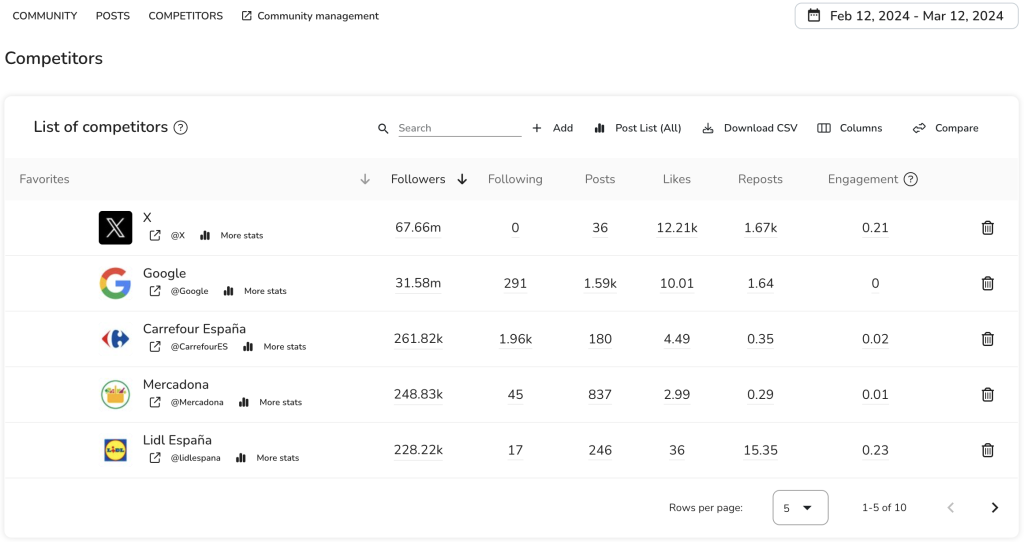X (Twitter) Benchmarking & Competitor Analysis

In social media, X (formerly Twitter) is a dynamic platform where brands engage, share, and connect. Understanding the landscape through X (Twitter) benchmarking and competitor analysis is crucial for those wanting to enhance their digital marketing strategy. Analyzing competitors and benchmarking your brand on X (Twitter) can be a game-changer for small businesses, influencers, entreprenHow Does the X (Twitter) Algorithm Work?eurs, and anyone looking to enhance their digital marketing strategy. Let’s dive into how leveraging Metricool can transform your approach to X (Twitter), providing a competitive edge and fostering growth for your brand.
What is a Competitor Analysis and Benchmarking?
A social media competitor analysis involves examining your competitors’ strategies and performance to gain insights that can help you gain an edge in your market or industry. Benchmarking, on the other hand, is the process of comparing your business metrics to those of your competitors. This comparison helps you understand where your brand stands in the market and identifies areas for improvement.
▶️ Research your Competitors with Metricool ◀️
Why is Benchmarking on X (Twitter) Important?
X (Twitter) is a dynamic platform where brands engage with their audience, share content, and participate in conversations. Benchmarking on X (Twitter) is crucial because it provides a yardstick to measure your performance against that of your competitors. It helps you understand how your content is performing, identify trends, and gauge customer sentiment towards your brand compared to others in your industry. Without benchmarking, it’s challenging to know whether your X (Twitter) strategy is effective or if it needs adjustment.
Some common metrics used for X (Twitter) benchmarking include:
- Engagement Rate: This measures the number of engagements (likes, retweets, replies, and quotes) your content receives as a percentage of your audience. It’s a key indicator of how much your audience interacts with your tweets.
- Impressions: This shows the total number of times your tweet has been seen. It’s important to understand the reach of your content and how often X (Twitter) is serving your tweets in users’ timelines.
- Follower Growth: Tracking the growth of your followers over time can indicate the effectiveness of your content strategy and your brand’s growing (or declining) popularity on the platform.
- Top Tweets: Identifying your top tweets by engagement or impressions over a selected period can help you understand what content resonates most with your audience.
- Top Mentions: Monitoring which accounts mention your brand and how often can provide insights into your brand’s visibility and the type of content your brand is associated with.
- Hashtag Performance: Analyzing the performance of hashtags you’ve used can inform your hashtag strategy and help you tap into trending topics or conversations.
- Video Activity: If you use video content on X (Twitter), tracking video views and engagement can be crucial for understanding how this content type performs on your X (Twitter) account.
- Audience Data: Understanding your audience demographics, interests, and behaviors can help tailor your content and engagement strategies.
How to Perform an X (Twitter) Competitive Analysis with Metricool
Metricool simplifies the process of conducting a competitive analysis on X (Twitter). Here’s how to get started:
1. Identify your competitors
Understand who your main competitors on X (Twitter) are. Make a list and organize it for easy reference.
There are two types of brand competitors– direct competitors (companies that sell the same product as you) and indirect competitors (companies that don’t sell the same product as you but could satisfy the same need). You can identify your brand’s competitors by tracking keywords, hashtags, and trends on X (Twitter).
▶️ How to Track Hashtags with Metricool ◀️
2. Use Metricool’s competitor analysis tool
Metricool allows you to benchmark and analyze your competitors on X (Twitter) (as well as Instagram and Facebook). To begin, log into Metricool, select X (Twitter), and click on the “Competitors” button at the top of the page.
Metricool allows free accounts to add up to five competitors for any brand, while premium accounts can add up to 100 competitors. Once your brand competitors are added to the list, Metricool will begin tracking their X (Twitter) data.

3. Analyze key metrics
Metricool provides detailed insights into various X (Twitter) metrics such as followers, following, tweets, likes, and retweets.
You can find an overview of your competitors’ analytics and compare two or more competitors, or select the graph icon “More stats” to see individual brands in deeper detail. From there you can find your competitor’s growth, posts, and interactions.

4. Download and organize data
For deeper competitor analysis, premium Metricool accounts can download their competitor data in CSV format. This allows you to manage the data in Excel, track changes over time, and add additional information for a more comprehensive analysis.
5. Compare results and optimize strategy
When analyzing competitors, it’s important to benchmark results against your own, to understand how your content performs against direct (and indirect) competitors. While this comparison reveals a reference point, it provides content and strategy opportunities. As you compare results and measure brand objectives, keep your overall strategy in mind.
X (Twitter) Competitor Benchmark Analysis for your Digital Strategy
Through competitive analysis, you can learn about your competitors’ strategies on X (Twitter)—what works for them and what doesn’t. This includes various aspects of their X (Twitter) activity, such as their follower demographics, content types, engagement tactics, and influencer partnerships. This information is key to refining your own X (Twitter) strategy. After conducting a thorough competitor analysis on X (Twitter) using Metricool, you can use the insights gained to benchmark your brand and refine your digital marketing strategy.
Content strategy
Analyzing your competitors’ top-performing tweets can inspire your content strategy. Compare your engagement rates and content types with those of your competitors. If certain types of posts are working well for them, incorporating similar themes or formats—without directly copying—can help improve your own content’s performance.
Example: A fashion brand sees a competitor’s high engagement with behind-the-scenes fashion show tweets. They adapt similar content, avoiding direct copying, to tap into their audience’s fashion interest.
▶️ How Does the X (Twitter) Algorithm Work? ◀️
Posting schedule
Analyzing both the timing and frequency of your competitors’ tweets can help you to pinpoint the ideal publication schedule for your brand. While there’s no universal rule for how often you should tweet, analyzing your competitors’ posting habits can help you find the right balance. Too few tweets may diminish visibility, while an excessive number could inundate your followers. By benchmarking against competitors, you can identify the optimal tweet ratio that keeps your audience engaged.
Example: A tech gadget business observes their competitor tweets frequency, finding a balance of twice daily posts to engage without overwhelming.
▶️ The Best Times to Post on X (Twitter) ◀️
Engagement tactics
Benchmarking allows you to measure how engaging your content is compared to your competitors. If competitors are achieving higher levels of X (Twitter) impressions and reach by sharing specific types of media content, it might be beneficial for you to adopt similar strategies. This insight helps in tailoring your content to increase engagement and reach on the platform. Look at how your competitors interact with their audience. Adopting similar engagement tactics, such as timely responses or interactive polls, can enhance your brand’s presence on X (Twitter).
Example: A food blogger notes competitors’ success with weekly recipe polls. They replicate the tactic, hosting their own polls to engage their audience in content creation.
Influencer partnerships
Benchmarking can reveal the accounts that contribute to your competitors’ visibility on X (Twitter). These might be influencers or regular users who have a significant following. By identifying and engaging with these users, you can potentially increase your brand’s visibility and engagement on the platform. Identify any influencers or notable accounts that engage with your competitors. These partnerships could be beneficial for your brand as well.
Example: A fitness brand notices competitors collaborating with fitness influencers. They reach out to similar influencers to broaden their reach and promote their products or services.
Adjust and monitor
The ultimate goal of benchmarking is to make informed decisions that enhance your brand’s performance on X (Twitter). By understanding where you stand in comparison to your competitors, you can set new goals and targets for improvement. This continuous improvement process can positively influence your brand’s sales, engagement, and overall presence on social media. Implement the insights gained from your analysis and continuously monitor the results. Adjust your strategy as needed to ensure ongoing improvement and relevance in your market.
Now is your turn to start benchmarking on X (Twitter). Metricool is here to help you out.
Have a tip for Twitter benchmarking? Leave a comment, We’re listening.

